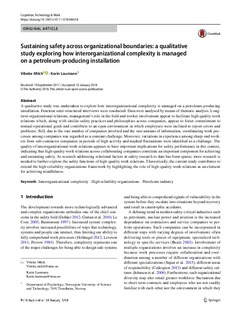| dc.contributor.author | Milch, Vibeke | |
| dc.contributor.author | Laumann, Karin | |
| dc.date.accessioned | 2019-02-28T14:09:13Z | |
| dc.date.available | 2019-02-28T14:09:13Z | |
| dc.date.created | 2018-04-17T11:13:24Z | |
| dc.date.issued | 2018 | |
| dc.identifier.citation | Cognition, Technology & Work. 2018, 20 (2), 179-204. | nb_NO |
| dc.identifier.issn | 1435-5558 | |
| dc.identifier.uri | http://hdl.handle.net/11250/2588098 | |
| dc.description.abstract | A qualitative study was undertaken to explore how interorganizational complexity is managed on a petroleum-producing installation. Fourteen semi-structured interviews were conducted. Data were analysed by means of thematic analysis. Long-term organizational relations, management’s role in the field and worker involvement appear to facilitate high-quality work relations which, along with similar safety practices and philosophies across companies, appear to foster commitment to mutual operational goals and contribute to an open environment in which employees were inclined to report errors and problems. Still, due to the vast number of companies involved and the vast amount of information, coordinating work processes among companies was regarded as a constant challenge. Moreover, variations in experience among sharp-end workers from sub-contractor companies in periods of high activity and marked fluctuations were identified as a challenge. The quality of interorganizational work relations appears to have important implications for safety performance in this context, indicating that high-quality work relations across collaborating companies constitute an important component for achieving and sustaining safety. As research addressing relational factors in safety research to date has been sparse, more research is needed to further explore the safety functions of high-quality work relations. Theoretically, the current study contributes to extend the high-reliability organizations framework by highlighting the role of high-quality work relations as an element for achieving mindfulness. | nb_NO |
| dc.description.abstract | Sustaining safety across organizational boundaries: a qualitative study exploring how interorganizational complexity is managed on a petroleum-producing installation | nb_NO |
| dc.language.iso | eng | nb_NO |
| dc.publisher | Springer Verlag | nb_NO |
| dc.relation.uri | https://link.springer.com/article/10.1007/s10111-018-0460-8 | |
| dc.rights | Navngivelse 4.0 Internasjonal | * |
| dc.rights.uri | http://creativecommons.org/licenses/by/4.0/deed.no | * |
| dc.title | Sustaining safety across organizational boundaries: a qualitative study exploring how interorganizational complexity is managed on a petroleum-producing installation | nb_NO |
| dc.type | Journal article | nb_NO |
| dc.type | Peer reviewed | nb_NO |
| dc.description.version | publishedVersion | nb_NO |
| dc.source.pagenumber | 179-204 | nb_NO |
| dc.source.volume | 20 | nb_NO |
| dc.source.journal | Cognition, Technology & Work | nb_NO |
| dc.source.issue | 2 | nb_NO |
| dc.identifier.doi | 10.1007/s10111-018-0460-8 | |
| dc.identifier.cristin | 1579735 | |
| dc.relation.project | Norges forskningsråd: 220798 | nb_NO |
| dc.description.localcode | © The Author(s) 2018 Open Access This article is distributed under the terms of the Creative Commons Attribution 4.0 International License (http://creativecommons.org/licenses/by/4.0/) | nb_NO |
| cristin.unitcode | 194,67,40,0 | |
| cristin.unitname | Institutt for psykologi | |
| cristin.ispublished | true | |
| cristin.fulltext | original | |
| cristin.qualitycode | 1 | |

